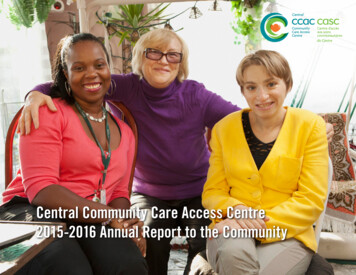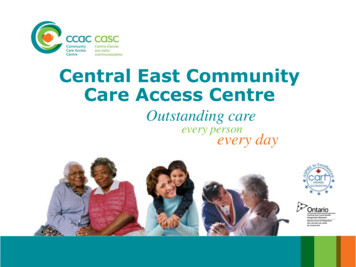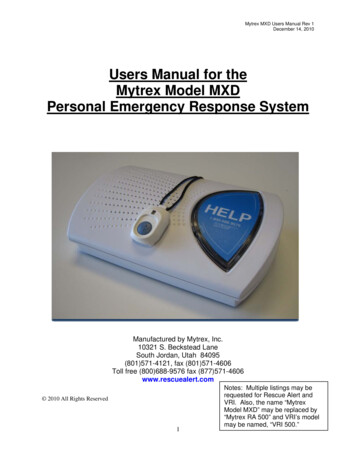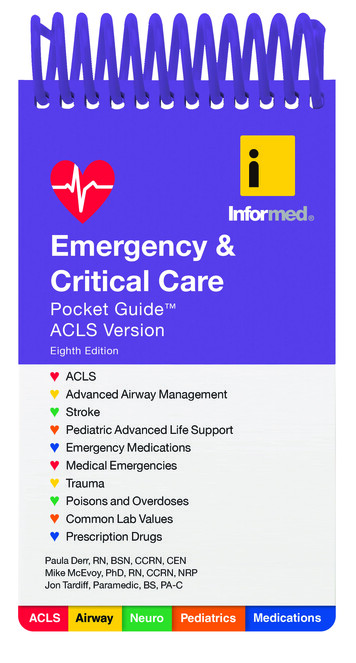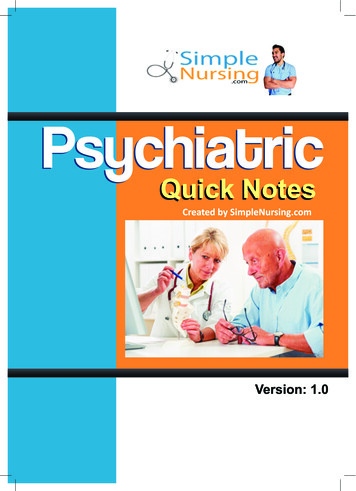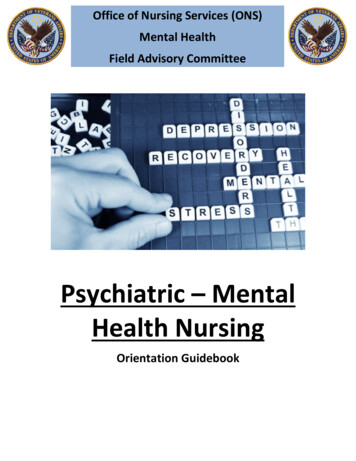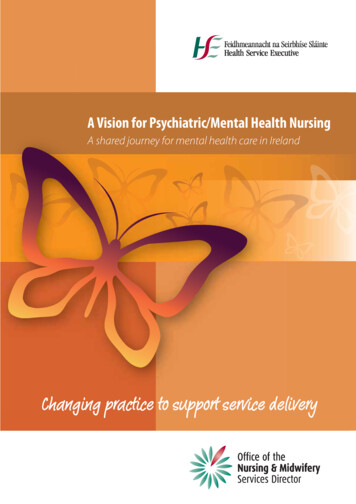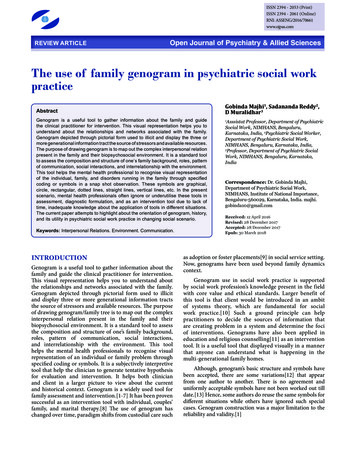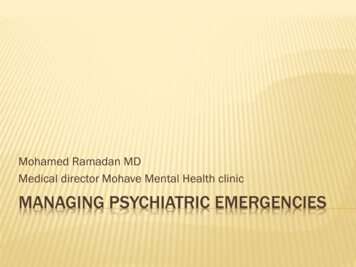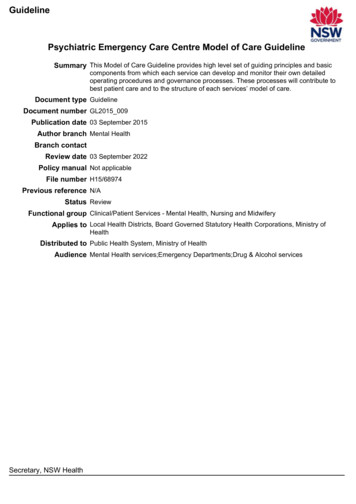
Transcription
GuidelinePsychiatric Emergency Care Centre Model of Care GuidelineSummary This Model of Care Guideline provides high level set of guiding principles and basiccomponents from which each service can develop and monitor their own detailedoperating procedures and governance processes. These processes will contribute tobest patient care and to the structure of each services’ model of care.Document type GuidelineDocument number GL2015 009Publication date 03 September 2015Author branch Mental HealthBranch contactReview date 03 September 2022Policy manual Not applicableFile number H15/68974Previous reference N/AStatus ReviewFunctional group Clinical/Patient Services - Mental Health, Nursing and MidwiferyApplies to Local Health Districts, Board Governed Statutory Health Corporations, Ministry ofHealthDistributed to Public Health System, Ministry of HealthAudience Mental Health services;Emergency Departments;Drug & Alcohol servicesSecretary, NSW Health
GUIDELINE SUMMARYPSYCHIATRIC EMERGENCEY CARE CENTREMODEL OF CARE GUIDELINEPURPOSEPsychiatric Emergency Care Centres (PECCs) were introduced in NSW from 2005 asone component of a series of strategies designed to enhance Mental Health (MH)Emergency Care services alongside community mental health teams, EmergencyDepartment mental health clinicians, consultation liaison psychiatry services, psychiatryregistrars and consultant psychiatrists.The earlier version of the PECC Operational Model of Care Guideline attempted toarticulate a consensus regarding detailed aspects of PECC operations. The facilities inwhich PECCs operate differ from each other including with regards to governance,overall mental health resources and how these resources are configured and managedand the physical location and design of the PECC and it has become apparent that it isneither desirable nor possible to standardise resourcing or service deliveryarrangements for managing the care of people with mental health problems includingthose presenting to Emergency Departments (ED).This updated PECC Model of Care Guideline provides high level guiding principles andbasic components from which each service can develop and monitor their own moredetailed operating procedures and governance processes which will contribute to bestpatient care and to the structure of each services’ model of care.KEY PRINCIPLESMH care in the ED is a collaborative process, with shared responsibility betweenEmergency Department and MH clinicians and managers and other specialities (e.g.Toxicology, Drug and Alcohol), where relevant. The relative portion of this sharedresponsibility varies according to individual patient needs and local servicearrangements.PECCs are integrated with a range of community-based and inpatient care options andrepresent the least restrictive hospital-based inpatient care option. It is intended to beutilised by consumers with low to medium acuity mental health problems for whom lessrestrictive care (e.g. community based care), is considered inappropriate and unsafeand who are likely to require only a brief (up to 48 hours) period of time in hospital.The guiding principles for PECCs are:1. Collaborative decision-making2. Least restrictive, short-term inpatient care3. Outcome based monitoring.USE OF THE GUIDELINEIt is the intention of this guideline that individual PECCs represent a locally determinedservice collaboration and configuration, based on the guided principles contained withinthis document. Services should monitor, evaluate and if necessary re-design theseGL2015 009Issue date: September-2015Page 1 of 2
GUIDELINE SUMMARYagreements by way of carefully chosen outcome and process data reflective ofimportant aspects of mental health emergency care.This document will assist in the process of establishing, monitoring or reviewing PECCservices, their role in the emergency space and in relation to the remainder ofcommunity - inpatient MH services.REVISION HISTORYVersionSeptember 2015(PD2015 009)Approved byDeputy Secretary,Strategy andResourcesAmendment notesNew guidelineATTACHMENTS1. Psychiatric Emergency Care Centre Model of Care Guideline.GL2015 009Issue date: September-2015Page 2 of 2
Psychiatric Emergency Care Centre Model of CareGuidelineGUIDELINEIssue date: September-2015GL2015 009
Psychiatric Emergency Care Centre Model of RNANCE AND MANAGEMENT .23CORE FEATURES OF A PECC SERVICE .33.1 Collaborative Care.33.2 Mental Health Assessment .43.3 PECC Inpatient Admission .43.4 Service components .53.5 Staffing .53.6 Discharge Planning / Transfer of Care.64MONITORING PECC PERFORMANCE .65SUPPORTING POLICIES .6PD2015 009Issue date: September-2015Contents page
Psychiatric Emergency Care Centre Model of CareGuidelineGUIDELINE1INTRODUCTIONPsychiatric Emergency Care Centres (PECCs) were introduced in NSW from 2005 asone component of a series of comprehensive strategies designed to enhance MentalHealth (MH) Emergency services.The facilities in which PECCs operate differ significantly from each other with regards togovernance, the overall mental health resources (community based and hospital), howthose resources are configured and managed, the policies and procedures that create aframework for provision of mental health assessment and treatment planning servicesand the physical design and layout of the PECC; for instance, whether there is physicalco-location with the Emergency Department (ED) or local arrangements for differenttriage points between MH and the ED.It is neither desirable nor possible to standardise resourcing, service deliveryarrangements or facilities for managing the care of persons with mental health problems.Earlier versions of the PECC Model of Care Guideline have attempted to articulate aconsensus regarding detailed aspects of PECC operations. However it has becomeapparent that the preferred approach is that this Model of Care Guideline provide arelatively high level set of guiding principles and basic components from which eachservice can develop and monitor their own more detailed operating procedures andgovernance processes which will contribute to best patient care and to the structure ofeach services’ model of care.The guiding principles for PECCs are:1. Collaborative decision-making2. Least restrictive, short-term inpatient care3. Outcome based monitoring.These principle-based guidelines are not intended to be prescriptive and lack the detail todescribe all aspects of PECC operations given that there are significant individualdifferences between existing PECCs and that there is no convincing evidence to supporta ‘preferred’ or ‘best practice’ model.This document will assist in the process of establishing, monitoring or reviewing PECCservices, their role in the emergency space and in relation to the remainder ofcommunity- inpatient MH services.It is the intention of this guideline that individual PECCs should represent a locallydetermined service collaboration and configuration, based on the guided principlescontained within this document. Services should monitor, evaluate and if necessary redesign these agreements by way of carefully chosen outcome and process datareflective of important aspects of mental health emergency care.MH care in the ED is a collaborative process, with shared responsibility between ED andMH clinicians and managers and other specialities (e.g. Toxicology, Drug & Alcohol(D&A)), where relevant. The relative portion of this shared responsibility varies accordingto individual patient needs and local service arrangements.It is quite clear from reviewing the performance of existing PECCs that the betteroutcomes for patient care, including the need to manage the physical health needs ofPD2015 009Issue date: September-2015Page 1 of 7
Psychiatric Emergency Care Centre Model of CareGuidelineGUIDELINEmental health consumers, occur where there is true collaboration and sharedresponsibility between MH and ED services from the point of entry to the ED to the pointof discharge from the PECC.By way of contrast, there are also some characteristic traits of those services performingless well when compared through measures such as the National Emergency AccessTarget (NEAT), Length of Stay (LOS), and incident or complaint reports. These traitsinclude a reluctance of MH services to assess consumers in the ED until they have been‘medically cleared’; and a reluctance of ED services to provide further medical review ofconsumers transferred to the PECC whose physical health has deteriorated. What candevelop in these services is an unhelpful ‘zone of demarcation’ between the ED and thePECC that interferes with timely assessment, care coordination and review by bothparties and which restricts the seamless flow of services between the ED and the PECCleading to prolonged patient journeys and poorer patient outcomes.PECCs are one component of the Mental Health Emergency Service, alongsidecommunity mental health teams, Emergency Department mental health clinicians,consultation liaison psychiatry services, psychiatry registrars and consultant psychiatrists.The PECC, in turn, is integrated with a range of community-based and inpatient careoptions and represents the least restrictive hospital-based inpatient care option. It isintended to be utilised by consumers with low to medium acuity mental health problemsfor whom less restrictive care (e.g. community based care), is considered inappropriateand unsafe and who are likely to require only a brief (up to 48 hours) period of time inhospital.The remainder of this guideline describes aspects of the model of care for PECCs whichmay assist those services that are establishing, reviewing or redesigning their PECC. It isexpected that services will develop local operating procedures and policies throughreference to this document which ensure the quality of care for the consumer, the safetyof everyone involved and consideration of available resources through a shared andcollaborative planning, monitoring and evaluation process which includes senior MH andED clinicians and managers.2GOVERNANCE AND MANAGEMENTPECCs are one of a suite of MH service options providing for short-term admission ofpeople with low to medium acuity mental health problems who present to the ED or otherestablished access points; and who do not require admission to an acute MH inpatientunit.MH staff provide ambulatory in-reach to the ED for MH assessment, immediate carecoordination, assistance with behaviour management and in managing the care ofconsumers in the ED requiring MH and D&A support (where there are no D&A specialiststaff available).A high level of collaboration and shared responsibility is necessary to safely manage thecare of people with mental health issues who present to the ED and has proven tofacilitate better outcomes for consumer care. Strong clinical leadership from both the EDand the MH service is required to support the collaborative process. It is essential thatmechanisms to maintain the relationship between the parties are established andsupported.PD2015 009Issue date: September-2015Page 2 of 7
Psychiatric Emergency Care Centre Model of CareGuidelineGUIDELINEA local governance committee comprising senior clinicians and managers from ED, MHservice (including PECC), D&A, should meet regularly as this is seen as an essentialmeans of supporting the collaborative relationship between the services. These meetingsshould be used as a forum to examine and discuss clinical and operational mattersincluding but not limited to:-Emergency Treatment Performance data-Critical incidents-Length of stay-Case reviews-Contentious cases-Joint Quality Improvement initiatives-Joint policy and procedural requirements / development-Clinical staff shared educational needs.Consumer and carer representative participation would be beneficial in an evolvingmodel of care.Sub-specialty services like Child & Adolescent Mental Health Services (CAMHS) andSpecialist Mental Health Services for Older People (SMHSOP) and other services shouldbe involved in these meetings where relevant.Representatives from security should also be involved where relevant.These discussions and review of data will influence the development of local processesand resource allocation with a view to improving patient care.These meetings may be a separate meeting to the local MOU or Interagency meetinginvolving Ambulance and Police, but not necessarily so.3CORE FEATURES OF A PECC SERVICEThe PECC provides the least restrictive hospital-based inpatient care. It is suitable formental health consumers with low to medium acuity mental health problems who arelikely to require a brief admission.PECCs are declared as mental health facilities to provide for the involuntary care andtreatment of patients under the Mental Health Act (NSW) 2007.3.1 Collaborative CareThe early engagement of the MH service will facilitate a timely determination ofappropriate patient disposition.
Psychiatric Emergency Care Centres (PECCs) were introduced in NSW from 2005 as one component of a series of strategies designed to enhance Mental Health (MH) Emergency Care services alongside community mental health teams, Emergency Department mental health clinicians, consultation liaison psychiatry services, psychiatry registrars and consultant psychiatrists. The earlier version of the PECC .
